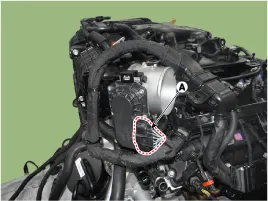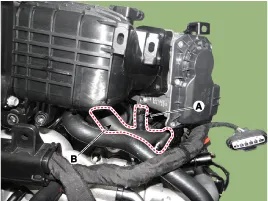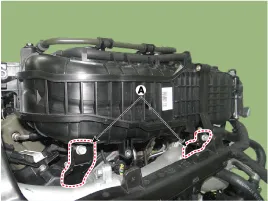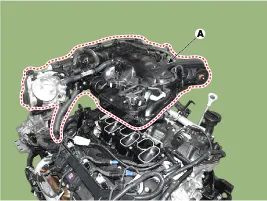Hyundai Genesis (DH): Intake And Exhaust System / Surge Tank Repair procedures
Hyundai Genesis (DH) 2013-2016 Service Manual / Engine Mechanical System / Intake And Exhaust System / Surge Tank Repair procedures
| Removal and Installation |
| 1. |
Disconnect the battery "-" terminal from the trunk room. |
| 2. |
Remove the engine cover. |
| 3. |
Remove the engine room cover.
(Refer to Engine And Transaxle Assembly - "Engine Cover") |
| 4. |
Remove the Cowl Top Cover.
(Refer to Body - "Cowl Top Cover") |
| 5. |
Remove the Engine room bulkhead (A).
|
| 6. |
Remove the air cleaner assembly.
(Refer to Intake Exhaust System - "Air Cleaner") |
| 7. |
Disconnect the fuel hose (A,B) and Brake vacuum hose (C).
|
| 8. |
Disconnect the PCSV connector (A).
|
| 9. |
Disconnect the VIS connector (A), Condenser connector (B), MAP sensor connector (C).
|
| 10. |
Disconnect the throttle body connector (A).
|
| 11. |
After loosening the fixing bolt, remove the wiring protector (A).
|
| 12. |
Remove the throttle body Cooling hose (A), PCSV hose (B).
|
| 13. |
Remove the surge tank fixing bracket (A).
|
| 14. |
Remove the surge tank (A).
|
| 15. |
To install, reverse the removal procedure. |
Components 1. Surge tank2. VIS actuator
Components 1. Intake manifold
Other information:
Hyundai Genesis (DH) 2013-2016 Service Manual: Head Up Display Unit Troubleshooting
T
Hyundai Genesis (DH) 2013-2016 Service Manual: Auto Defogging Actuator Description and Operation
Description The auto defogging sensor is installed on front window glass. The sensor judges and sends signal if moisture occurs to blow out wind for defogging. The air conditioner control module receives a signal from the sensor and restrains moisture and eliminates defog by the intake actuator, A/C, auto defogging actuator, blower motor
Categories
- Manuals Home
- Hyundai Genesis Owners Manual
- Hyundai Genesis Service Manual
- Body Electrical System
- Driveshaft and axle
- Heating, Ventilation and Air Conditioning
- New on site
- Most important about car
Copyright © 2025 www.hgenesisdh.com - 0.0219











